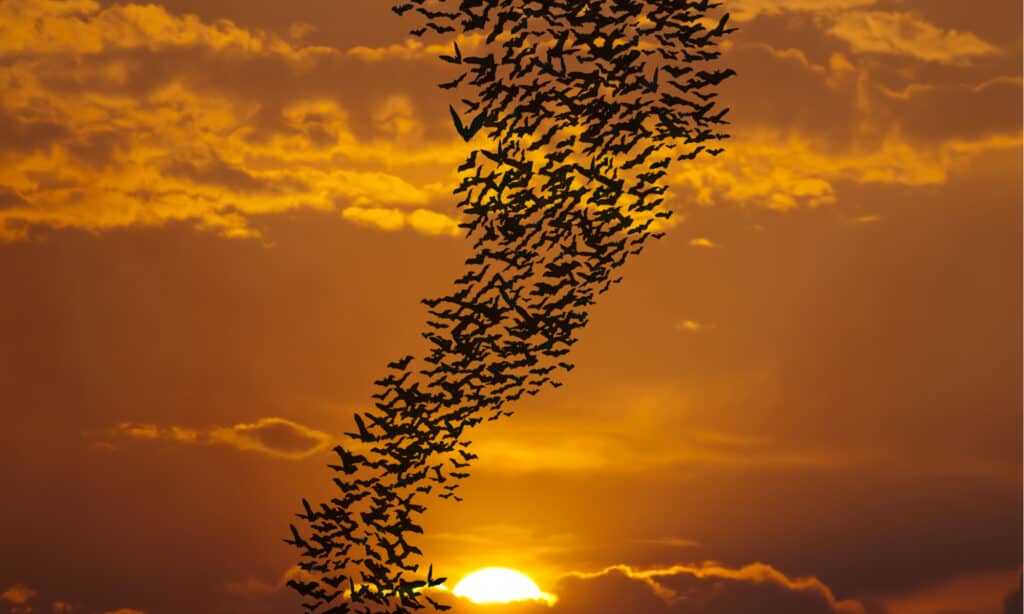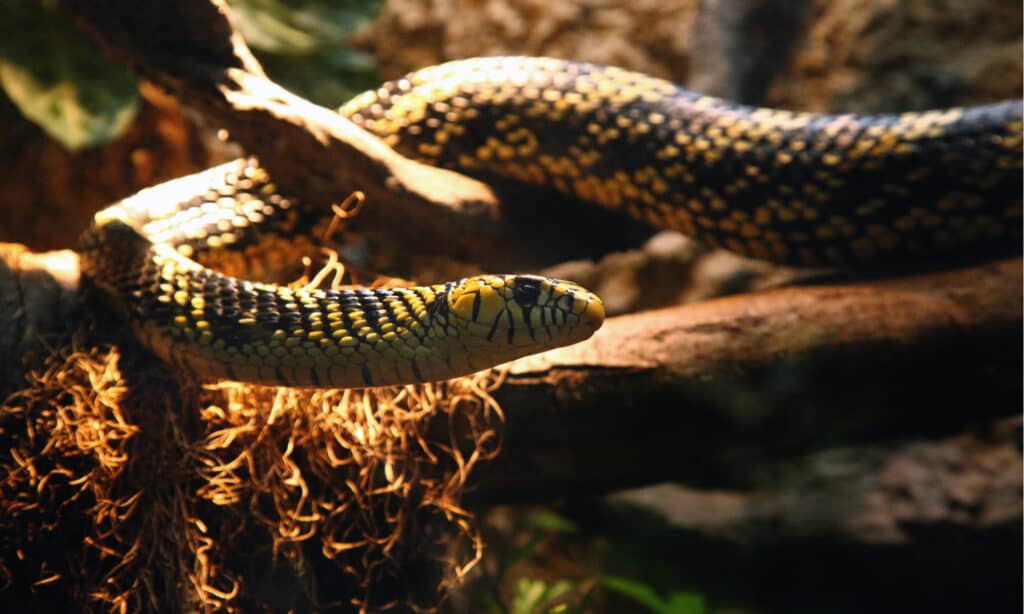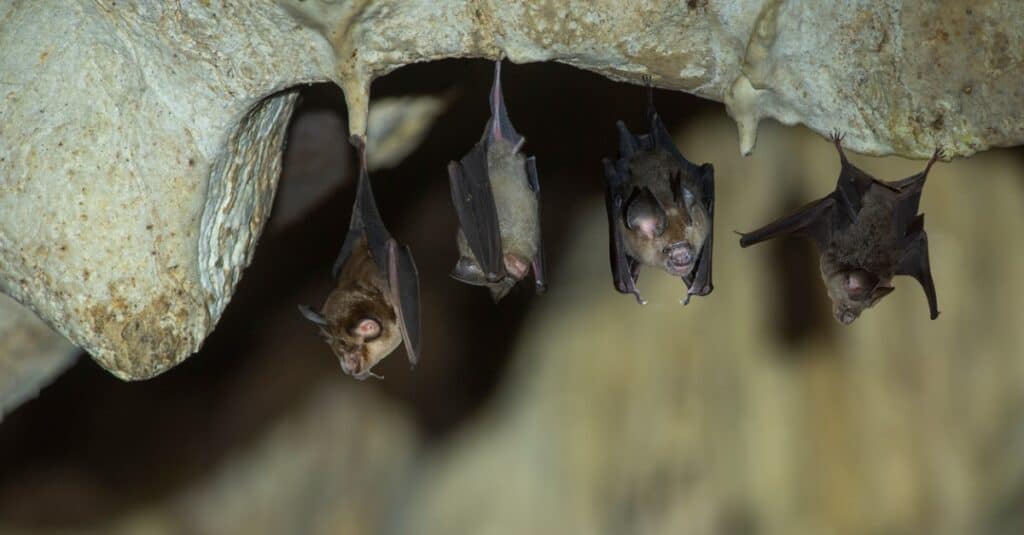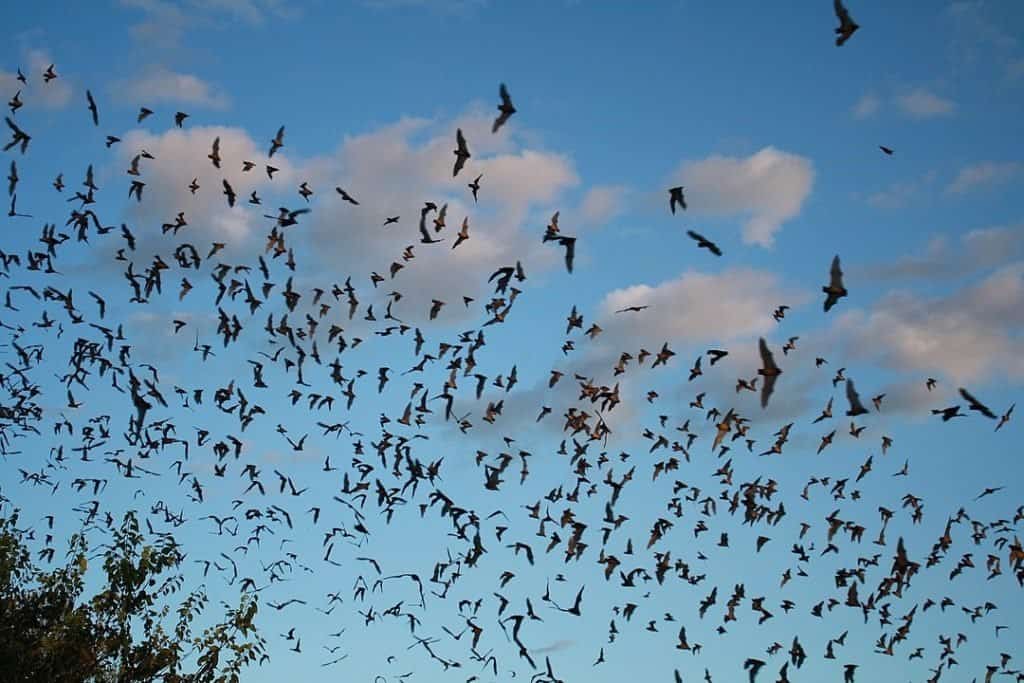As the light fades and dusk approaches outside the Kantemó Cave in Mexico, its inhabitants begin to stir. When darkness finally falls, hundreds of thousands of bats swarm through the cave’s mouth, venturing off in search of food. This natural scene is an astonishing sight, but the real treat is reserved for those brave enough to venture inside the cave. Kantemó Cave is also known as Las Cuevas de las Serpientes Colgantes, or the “Cave of the Hanging Serpents.” Within its hollows, blind and deaf snakes hang off ceilings to hunt for dinner. But don’t worry, humans aren’t on the menu—it’s the bats that these snakes find tasty.
The “Hanging Serpents” of Kantemó Bat Cave

The snakes in Kantemó Cave are deaf and blind, but that doesn’t stop them from preying bats.
©Sarun T/Shutterstock.com
The hanging serpents of the Kantemó Bat Cave may seem like something out of a nightmare. However, these snakes are actually quite harmless to humans. They are non-venomous, as well as deaf and nearly blind! These snakes live generally quiet lives deep in the rock crevices of Kantemó Cave. During the day, all remains quiet as the snakes sleep alongside bats and other cave creatures. But in the blackness of night, these snakes reveal their darker side.
Emerging from their hiding places in the rocks, the snakes extend their long bodies and hang from the ceiling vertically. Swaying like flags in the wind, these snakes wait for a bat to fly close. When one does, SNAP! It’s gone. Yes, these snakes snatch bats right out of the air with terrifying precision.

Rat snakes are non-venomous constrictors that are harmless to humans.
©Ixepop/Shutterstock.com
Scientists believe that this unique group of yellow-red rat snakes have lived in Kantemó Cave for at least 200 years. Yellow-red rat snakes dwell in the tropical forests of Mexico, Guatemala, Belize, Nicaragua, and Honduras. Typically, these snakes eat small ground-dwelling animals like lizards and rodents. The yellow-red rat snakes of Kantemó, however, have adapted to living in the complete darkness. They feast entirely on a diet of bats. Six different species of bats fly in and out of Kantemó Cave on a nightly basis. So, within their limited menu, the snakes at least have a handful of dinner choices.
Why Snakes Adapted to the Cave-Dwelling Life
Dwelling in utter darkness might seem strange, but there are many benefits for a snake living in Kantemó Cave. The cave keeps a consistent temperature throughout the year. The snakes are top of the food chain since there are no natural predators sharing the cave with them. And of course, each night the snakes can enjoy an abundant feast that literally flies straight into their mouths! Catching bats in mid-flight is not an easy task, especially for a creature that is both blind and deaf. The Kantemó snakes, however, can feel the vibrations of the bats as they fly, and strike with tremendous precision.
The Discovery of the Kantemó Bat Cave

Snakes in “The Cave of Hanging Serpents” can eat four to five bats in a single night.
©iStock.com/BirdHunter591
Kantemó Bat Cave is tucked away in the jungle forest of Mexico’s Yucatan Peninsula. It is over one hundred miles inland from the Ancient Maya ruins of Tulum. The cave was carved away over millions of years by water runoff and rainfall. The nearby village of Kantemó is home to many people of Mayan descent. They have protected the cave for hundreds of years as part of their cultural heritage.
However, this secret place was one where few wished to go. The people of Kantemó feared the ancient legends that told of evil cave-dwelling spirits that could hurt their children. The Ancient Maya saw caves as entrances to the underworld. Bats were associated with night, death, and sacrifice. When biologist Miramontes arrived in the area, he needed to convince locals to allow him to explore the cave alone.

A group of bats is called a colony, cloud, cauldron, or camp.
©U.S. Fish and Wildlife Service Headquarters / CC BY 2.0 – License
Bayona Miramontes found masses of bats in the cave, as well as ancient Maya pots. However, the real discovery came when he and his assistant were biking at night four months later. They saw enormous hordes of bats flying from the cave entrance. The two moved closer and eventually ventured inside the cave. That is when they saw hundreds of snakes slithering across the cave’s ceiling and hanging upside down as bats continued to fly by, snatching them out of midair. The experience captivated Boyona Miramontes and he spent the next three months studying this phenomenon. He even slept inside the cave at one point to confirm that the snakes came out to feed both when the bats left and when they returned.
The Bat Cave as an Ecotourism Destination

Many Kantemó locals are Maya descendants who guide and educate visitors about the cave.
©chrisontour84/Shutterstock.com
Although the locals were hesitant at first, they have since joined in the development of ecotourism in Kantemó. However, there are safety measures in place to help protect the cave and keep its ecosystem in balance. Visitors must sign up with a licensed guide, and only 10 visitors can enter the cave at a time. There is no photography once inside the cave. On average, only around 300 people visit the Kantemó Cave each year.
Experiencing the Hanging Serpents of Kantemó Cave
So, what is the Kantemó cave like? Equipped with helmets, headlamps, gloves, and masks, visitors to Kantemó Cave are briefed on what to expect. Guides remind them not to touch the animals, then proceed through the 65-foot-wide cave mouth. Once inside the heavy darkness of the cave, visitors crawl on their hands and knees in tight spaces while thousands of bats flutter around their heads.
It is an up-close and intimate experience. You can hear and feel the rush of the bats’ wings as they sweep past—and on occasion, a bat may accidentally bump into you on its way in or out of the cave. The encounter is both terrifying and spectacularly mind-blowing, a once-in-a-lifetime experience to be sure.
Along with the bats and ceiling-hanging-snakes, there are also many other remarkable features to see inside Kantemó Cave. Water in the cave provides a home to the eyeless White Lady, a fish endemic to the Yucatan Peninsula. The Blind Brotula, a transparent eel, also lives in the cave and is the only known species of its kind. Additionally, there are many troglofauna and stygofauna like shrimp, albino crustaceans, mealybugs, and algae. The cave’s ceiling is covered by ancient fossils and stalactites from the ancient seabed that was once part of the Yucatan Peninsula.
The photo featured at the top of this post is © Hoang Trung/Shutterstock.com
Discover the "Monster" Snake 5X Bigger than an Anaconda
Every day A-Z Animals sends out some of the most incredible facts in the world from our free newsletter. Want to discover the 10 most beautiful snakes in the world, a "snake island" where you're never more than 3 feet from danger, or a "monster" snake 5X larger than an anaconda? Then sign up right now and you'll start receiving our daily newsletter absolutely free.
Thank you for reading! Have some feedback for us? Contact the AZ Animals editorial team.






